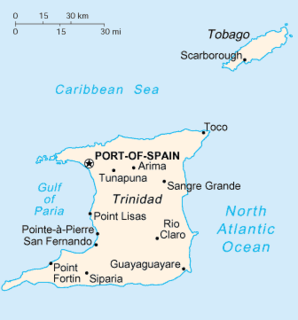This article is about the demographic features of Guyana, including population density, ethnicity, education level, health of the populace, economic status, religious affiliations and other aspects of the population.
The recorded history of Guyana can be dated back to 1466, when Guyana de Ojeda's first expedition arrived from Spain at the Essequibo River. The history of Guyana has been shaped by the participation of many national and ethnic groups, as well as the colonial policies of the Spanish, French, Dutch, and British. The African slave rebellions in 1763 and 1823 were seminal moments in the nation's history. Africans were enslaved and transported to Guyana as slaves; in contrast, East Indians came as indentured labourers. Guyana's recent history is characterized in particular by the struggle to free itself from colonial rule, and from the lingering effects of colonialism.
Guyanese culture reflects the influence of Indian, African, Amerindian, British, Portuguese, Chinese, and Dutch cultures. Guyana is one of a few mainland territories of South America that is considered to be a part of the Caribbean region. Guyanese culture shares many commonalities with the cultures of islands in the West Indies,

Hindu communities are found in several countries of South America, but they are strongest in Guyana and Suriname. There are about 550,000 Hindus in South America, chiefly the descendants of Indian indentured labourers in the Guianas. There are about 270,000 Hindus in Guyana, 150,000 in Suriname, and some others in French Guiana. In Guyana, Hindus form 35% of the population.
Indo-Caribbeans are Caribbean people with roots in the Indian subcontinent. They are mostly descendants of the original jahaji indentured workers brought by the British, the Dutch and the French during colonial times.

Linden Forbes Sampson Burnham was a Guyanese political leader and leader of Guyana from 1964 until his death, as the first Prime Minister from 1964 to 1980 and as second President from 1980 to 1985. He is widely regarded as a strongman who fought for nationalism and encouraged Guyanese to manufacture and export more local product.
Afro-Guyanese people are inhabitants of Guyana who are of Sub-Saharan African descent, generally descended from slaves brought to the Guianas to work on sugar plantations.
Clem Seecharan is a writer and historian of the Indo-Caribbean experience, and of West Indies cricket, who was born in Guyana and has been based in England since 1986.

Hinduism is a minority religion in French Guiana, introduced and practiced mostly by the descendants of the Indo-Guyanese, who in 2014 numbered around 360,000.As of 2010,Hinduism is followed by 1.6% of the population of French Guiana.
Indo-Jamaicans or Indian-Jamaicans, are the descendants of people who came from the Indian subcontinent to Jamaica and are the descendants of citizens or nationals of Jamaica. Indians form the third largest racial group in Jamaica after Africans and non-African Multiracials. However, because most African-mixed Jamaicans self-report as 'black', the population of people with partial Indian ancestry is estimated to be much larger. Along with the Chinese and Arabs, Indians represent the wider Asian community on the island, and have made a significant impact on its culture.

Guyanese people are people identified with the country of Guyana, which is located on the northern coast of South America and is bordered by the Atlantic Ocean, Brazil, Venezuela and Surinam. Geographically, Guyana is part of the South American mainland, however it is much more culturally similar to the nearby island nations of the Caribbean such as Trinidad and Tobago, Barbados, Saint Vincent and the Grenadines and Grenada with respect to culture. In fact, Guyana is considered a Caribbean country even though it is not an island nation located in the Caribbean Sea, as are most Caribbean nations.

Guyanese Americans are Americans who can trace their ancestry back to Guyana.
The Chinese community played an important role in British Guiana beginning in 1853, supplying independent Guyana its first President, Arthur Chung, from 1970 to 1980. The Chinese are one of the "six peoples" celebrated in Guyana's national anthem. The 20th century saw substantial emigration by the Chinese Guyanese professional class, a process accelerated following independence, making the Chinese Guyanese principally a diaspora community today.
The Progressive Youth Organisation of Guyana is a youth organisation in Guyana, the youth wing of the People's Progressive Party. The membership of Progressive Youth Organisation (PYO) is predominately Indo-Guyanese, like its mother party.
The Indian community in Saint Kitts and Nevis is made up of Indo-Kittitians, Indo-Nevisians, non-resident Indians and persons of Indian origin. Indo-Kittitians and Indo-Nevisians are nationals of Saint Kitts and Nevis whose ancestry lies within the country of India. The community originated from the Indian indentured workers brought to Saint Kitts and Nevis by the British in 1861 and 1874 respectively. By 1884, most of the community had emigrated to Caribbean nations with larger Indian populations such as Trinidad and Tobago, Guyana and Suriname.

Hinduism is the second-largest religion in Suriname. According to the 2012 census of Suriname, Hindus constitute 22.3% of the population. Suriname has the second largest percentage of Hindus in the Western Hemisphere, after Guyana (24.8%).Suriname is also the only country in South America with an increasing Hindu population, both in percentage and absolute terms.

Hinduism is the religion of 24.8% of the population of Guyana. Guyana has the highest percentage of Hindus in the Western Hemisphere.














